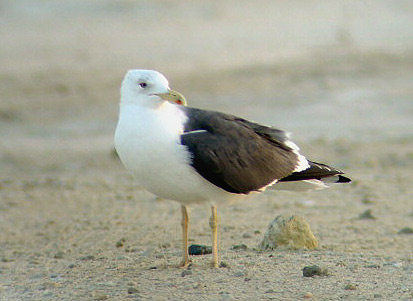 Heuglin's Gull (L. heuglini / antelius)
Heuglin's Gull (L. heuglini / antelius)
(last update:
Heuglini / paler end fuscus? adult, February 26 2001, Bahrain: Muharraq jetty.
Features suggesting heuglini in these pictures are the mean beady eye in the angry face combined by upper parts which are much darker than in the commonest species in Bahrain: barabensis.
As can be seen in the pictures, some coverts have a brown hue while some look rather grey-brown. Probably these feathers belong to different generations. In the Netherlands, we may see such a brown cast over the wing coverts as well; as it seems, more often in old coverts in the type intermedius from Scandinavia. Another indication for heuglini, which is a late moulting species, are the primary tips which look brand new, recently moulted. The size of the tips is very variable in the LBBG complex and these primary tips fall well in the variation. It is said that the size of the mirror on P10 and the distance to the very tip may be a clue for heuglini, but we don't know of any comparative study on this.
Structurally, the head shape is angular in this individual, suggesting it might be a male. Most reliable feature for heuglini might be the bill, which can look very cachinnans-like: slender, without a clear gonydeal angle, pale yellow. This, together with the sloped head makes the bill look longer than in most intermedius.
Another cachinnans-like feature is the head pattern. Winter streaking seems to be concentrated in the lower neck and the band sometimes continues on the side-neck, creating a collar of fine streaks, as can be seen in (sub-adult early winter) cachinnans.
Of course this discussion is only hypothetic for the Arabian Gulf region. Probably intermedius and graellsii do not reach Bahrain (yet?). Another point is the variation in heuglini type gulls we found (mainly) along the shores of Bahrain. The more robust, strong type of gull, showing the dark upper parts was pretty easy to distinguish. Among the gulls with such a dark grey mantle-tone, much smaller, more gently built birds (females?) were present. In general structure they come very close to fuscus, and it's just the feeling they are too pale to be fuscus, making us call them heuglini. From the pictures published on the web and in magazines of heuglini visiting Finnish landfills in early summer, we feel these heuglini might resemble and approach the general structure of fuscus. Maybe they originate from the Archangelsk region.
A general clue for adults in the Persian Gulf: note the relative freshness of the primary tips, suggesting primary moult has finished not very long ago as is commonly seen in the tundra breeding species fuscus and heuglini; contra early breeding species as barabensis and cachinnans, which often have the primary tips worn by late winter.

